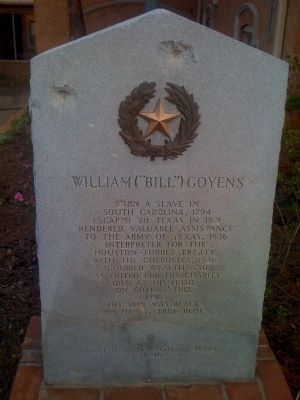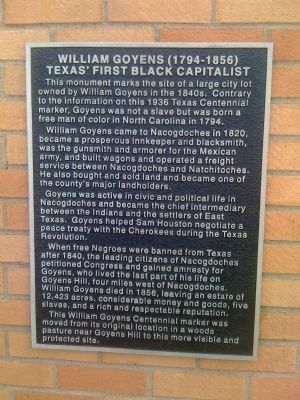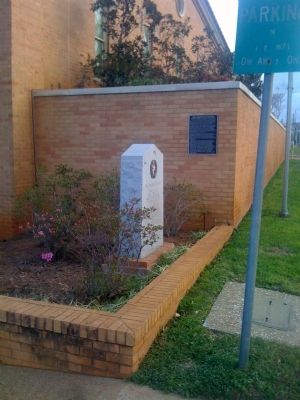Nacogdoches in Nacogdoches County, Texas — The American South (West South Central)
William ("Bill") Goyens
Texas' First Black Capitalist
— 1794-1856 —
Escaped to Texas in 1821
Rendered valuable assistance to the Army of Texas, 1836
Interpreter for the Houston-Forbes Treaty with the Cherokees, 1836
Acquired wealth and was noted for his charity
Died at his home on Goyens' Hill
1856
His skin was black
His heart, true blue
Accompanying metal marker:
This monument marks the site of a large city lot owned by William Goyens in the 1840s. Contrary to the information on this 1936 Texas Centennial Marker, Goyens was not a slave but was born a free man of color in North Carolina in 1794.
William Goyens came to Nacogdoches in 1820, became a prosperous innkeeper and blacksmith, was the gunsmith for the Mexican Army, and built wagons and operated a freight service between Nacogdoches and Natchitoches. He also bought and sold land and became one of the county's major landholders.
Goyens was active in civic and political life in Nacogdoches and became the chief intermediary between the Indians and the settlers of East Texas. Goyens helped Sam Houston negotiate a peace treaty with the Cherokees during the Texas Revolution.
When free Negroes were banned from Texas after 1840, the leading citizens of Nacogdoches petitioned Congress and gained amnesty for Goyens, who lived the last part of his life on Goyens Hill, four miles west of Nacogdoches. William Goyens died in 1856, leaving an estate of 12,423 acres, considerable money and goods, five slaves, and a rich and respectable reputation.
This William Goyens Centennial Marker was moved from its original location in a woods pasture near Goyens Hill to this more visible and protected site.
Erected 1936 by State of Texas. (Marker Number 9275.)
Topics and series. This historical marker is listed in these topic lists: African Americans • Industry & Commerce • War, Texas Independence. In addition, it is included in the Texas 1936 Centennial Markers and Monuments series list. A significant historical year for this entry is 1794.
Location. 31° 36.209′ N, 94° 39.381′ W. Marker is in Nacogdoches, Texas, in Nacogdoches County. Marker is on South Street (State Highway 7) just south of Main Street (State Highway 21), on the right when traveling south. Touch for map. Marker is at or near this postal address: 101 W Main Street, Nacogdoches TX 75961, United States of America. Touch for directions.
Other nearby markers. At least 8 other markers are within walking distance of this marker. Old Spanish Cemetery (within shouting distance of this marker); Nacogdoches County Veterans Memorial (within shouting distance of this marker); Johnson Furniture (within shouting distance of this marker);
Forgotten Theater (within shouting distance of this marker); Military Order of the Purple Heart (within shouting distance of this marker); Battle of Nacogdoches (within shouting distance of this marker); El Camino Real — Kings Highway (within shouting distance of this marker); On this site stood the old "Red House" (within shouting distance of this marker). Touch for a list and map of all markers in Nacogdoches.
Additional commentary.
1. Bill Goyens, Jr. was Native American, not Black
In his homeland of North Carolina court records show his father owned land on Pocket Creek in 1764. Descendents of this family still live there. Vital records also reveal this family as Native American and a document states William Goyens, Jr was the grandson of a mixed-Portuguese. This document was attested to by five upstanding citizens who knew this family in 1882. Goyens fought with the Cherokees as a Cherokee in important battles and was well acquainted with Chief Bowles, Sam Houston and Big Mush before arriving in Texas. He is simply mislabeled because there was not a category for Native Americans, Mediterraneans, Turkish, Spanish or dark complected peoples in census forms. There was no room for diversity or multi-ethnic peoples. He was non-white, so everyone assumed he was African. DNA records in this family are 91% European, 8% Native at this time (indicated Goyens was 75% or more Native American according to DNA specialists), 0% Asian and 0% African. The main population contributors in this family are (1) Morocco (Berber) (2) Spanish (3) Turkish (4) Greece and (5) Native American.
The original owner of the land where Goyens' marker was first placed, stated that the area was fenced off prior to marker and was always believed to be where Goyens was buried. The Texas Centennial Commission wrote in their published research that they had established that place as his grave and the marker was one of only 13,000 in Texas to be placed on a gravesite. When the marker was removed from Goyens Hill, Goyens' grave was lost since no one bothered to erect a new headstone. Contemporary historians believe historians from 1936 didn't know what they were doing when they placed the marker in the middle of a fenced in area in a cow pasture. I believe the old scholars did their homework and truly did know the site where they erected the marker was indeed his gravesite. Contemporary scholars have no idea where his grave is. They only speculate. But there was a time when the people of Nacogdoches did know. It is sad that this Native American hero is obscured with mislabels and has no recognized resting place.
School children used to go up to the gravesite (the site of the original marker) and place wreaths at the grave. Now there is no place for people to honor him and as family, we can only walk to the place where we think the original marker was and whisper a prayer.
And though he was not African, he was a mixed-blood Indian who had to walk between two worlds - the Red one and the White one. He was discriminated against. He was caught to be sold as a slave - as auction blocks in New Orleans sold Native Americans as slaves also. And he overcame the racial hatred (being shot), being captured for slavery and denied citizenship twice in Texas because of the color of his skin. So he is still a champion for all People of Color or anyone who had to endure those challenges. It was a complex time in history, and the answer is not Black or White. Note To Editor only visible by Contributor and editor
— Submitted May 1, 2011, by Cyndie Goins Hoelscher of Corpus Christi, Texas.
Credits. This page was last revised on April 12, 2021. It was originally submitted on April 4, 2010, by Steve Gustafson of Lufkin, Texas. This page has been viewed 3,054 times since then and 207 times this year. Photos: 1, 2, 3. submitted on April 4, 2010, by Steve Gustafson of Lufkin, Texas. • Kevin W. was the editor who published this page.


